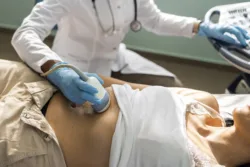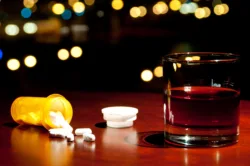Co-Occurring Disorders: Bipolar and Substance Abuse

Substance use disorders (SUDs) frequently co-occur with other mental health disorders, such as anxiety and depression. Bipolar disorder also has a high co-occurrence rate with substance use. About 2.5% of the U.S. population, or 6 million people, has some form of bipolar disorder.
Lifetime prevalence of SUDs for individuals with bipolar I is between 40% and 70%, with many abusing alcohol. Other research has found that people with bipolar disorder are at a greater risk of substance abuse than the general population.
Not only do bipolar and substance use co-occur, but they also have symptoms that mimic each other. This can make diagnosis and treatment even more complex. Importantly, those with bipolar and addiction require effective, comprehensive treatment. Learn more about the two disorders and their comorbidity.
Treatment for Bipolar and SUDs
What Is Bipolar Disorder?
Bipolar disorder is a serious mental health condition characterized by extreme mood swings, or episodes of depression and mania. There are seven types of bipolar diagnoses in the latest edition of the Diagnostic and Statistical Manual of Mental Disorders (DSM–5):
- Cyclothymia (or Cyclothymic Disorder)
- Bipolar Disorder I
- Bipolar Disorder II
- Other types: Substance/Medication-Induced Bipolar and Related Disorder, Bipolar and Related Due to Another Medical Condition, Other Specified Bipolar and Related Disorder, and Unspecified Bipolar and Related Disorder
What Are the Symptoms of Bipolar Disorder?
Symptoms of bipolar disorder do not necessarily occur together, so an accurate diagnosis can be difficult. For example, some patients may only seek help during a depressive episode. Some people even experience both manic and depressive episodes together or in rapid sequence, known as episodes with mixed features.
Clinicians will assess symptoms, including severity, frequency, and duration to diagnose bipolar disorder. Those with bipolar I disorder have experienced at least one manic episode. A depressive episode is not required for a bipolar I diagnosis, but depression is common.
For a bipolar II diagnosis, individuals have had at least one hypomanic episode and one depressive episode.
Mania
During manic episodes, people with bipolar disorder experience extreme emotional highs that can sometimes be dangerous. Symptoms of mania include:
- Inflated sense of self or grandiosity
- Lack of sleep
- Sustained and abnormal energy levels
- Significantly increased activities
- Decreased inhibitions
- Restlessness or inability to sit still
- Visual or auditory hallucinations
- Paranoia
Hypomania is a milder form of mania, which can appear as elevated mood, sex drive, or productivity. Hypomania is seen in individuals with bipolar II disorder.
Depression
People with bipolar disorder often have intense episodes of depression. This may last from a few days to several weeks. Depressive symptoms include:
- Prolonged sadness or depressed mood
- Fatigue
- Insomnia or too much sleep
- Loss of interest or pleasure in activities
- Feelings of guilt or hopelessness
- Memory loss
- Inability to concentrate
- Suicidal thoughts
What Is Substance Use Disorder?
Substance use disorders occur when repeated use of drugs or alcohol causes significant impairment to a person’s physical and emotional health, relationships, and responsibilities such as school or work.
The DSM-5 has 11 criteria for a diagnosis. The number of symptoms determines the severity of the disorder: mild, moderate, or severe.
What Are the Symptoms of Substance Use Disorder?
The severity of symptoms varies, but these are some common symptoms of SUDs:
- Difficulty concentrating or remembering things
- Changes in hygiene
- Social impairment
- Periods of intense euphoria, highs or elevated moods
- Bouts of paranoia
- Hallucinations and confusion
- Irritability and mood swings
- Aggression
- Unpredictable behavior
Can Substance Use Cause or Worsen Bipolar Disorder?
People who are predisposed to bipolar disorder are at a greater risk of abusing substances. Drugs or alcohol could be used to self-medicate, or cope with symptoms of mania or depression.
People who are already diagnosed with bipolar disorder may also experience more intense highs or lows when using substances. Each disorder can also exacerbate symptoms of the other disorder. There’s an increased risk of severe mood swings, depression, and suicide.
In addition, symptoms of substance use and bipolar disorder can look very similar. Someone in a manic episode experiencing impulsivity or irritability can appear similar to someone who is abusing substances.
Furthermore, there is also a type of bipolar disorder known as substance/medication-induced bipolar.
Substance/Medication-Induced Bipolar and Related Disorder
The DSM-5 also includes substance/medication-induced bipolar, meaning there are mood changes when taking or stopping a substance. Many substances can alter the brain’s chemistry, leading to mania or depression that can last several days or weeks.
Substances that can cause mood manic or depressive symptoms include:
- Opioids such as heroin
- Alcohol
- Amphetamines
- Cocaine
- Hallucinogens
- Corticosteroids
- Levodopa (used to treat Parkinson’s disease)
For a substance-induced bipolar diagnosis, it must be clear that a substance or medication led to symptoms or an episode. Symptoms need to be prominent and persistent, starting when a medication is taken or during withdrawal.
Symptoms without the presence of substances are more likely to be associated with bipolar I or II.
All of the factors previously mentioned can make bipolar disorder difficult to diagnose and treat, especially in people who also have a drug addiction. It’s important to assess the whole person. Mental health history is a critical part of the assessment process in addiction treatment.
Treatment for Bipolar and Substance Use Disorders
Each person is unique and symptoms may vary in individuals with bipolar and substance use disorders. No one treatment works for everyone. Fortunately, there are therapies and medications available. For example, cognitive behavioral therapy (CBT) has proven effective in treating both disorders. CBT helps identify thoughts, emotions, and behaviors that contribute to the disorder. Clients learn coping techniques, including how to replace negative thoughts with positive actions.
A combination of medications and therapy often works best for people with bipolar disorder. Medications may include SSRIs or antipsychotics. Similarly, Medication-Assisted Treatment (MAT) has proven to be effective for people with opioid use disorders. MAT combines therapy with medications that can prevent cravings and block the effects of opioids.
Learn more about Medication-Assisted Treatment.
Dual Diagnosis Treatment
Importantly, dual diagnosis treatment can help individuals treat symptoms of both conditions simultaneously. For people with co-occurring disorders, this type of treatment is usually more effective than treating one disorder before another.
Pyramid Healthcare provides services for adults and teens with co-occurring mental health disorders
If you or a loved one is experiencing symptoms of bipolar disorder or addiction, it’s important to contact a mental health professional. An accurate diagnosis is a key first step to getting the treatment you need.
To learn more about dual diagnosis treatment, call Pyramid Healthcare.
Substance use disorders (SUDs) frequently co-occur with other mental health disorders, such as anxiety and depression. Bipolar disorder also has a high co-occurrence rate with substance use. About 2.5% of the U.S. population, or 6 million people, has some form of bipolar disorder.
Lifetime prevalence of SUDs for individuals with bipolar I is between 40% and 70%, with many abusing alcohol. Other research has found that people with bipolar disorder are at a greater risk of substance abuse than the general population.
Not only do bipolar and substance use co-occur, but they also have symptoms that mimic each other. This can make diagnosis and treatment even more complex. Importantly, those with bipolar and addiction require effective, comprehensive treatment. Learn more about the two disorders and their comorbidity.
Treatment for Bipolar and SUDs
What Is Bipolar Disorder?
Bipolar disorder is a serious mental health condition characterized by extreme mood swings, or episodes of depression and mania. There are seven types of bipolar diagnoses in the latest edition of the Diagnostic and Statistical Manual of Mental Disorders (DSM–5):
- Cyclothymia (or Cyclothymic Disorder)
- Bipolar Disorder I
- Bipolar Disorder II
- Other types: Substance/Medication-Induced Bipolar and Related Disorder, Bipolar and Related Due to Another Medical Condition, Other Specified Bipolar and Related Disorder, and Unspecified Bipolar and Related Disorder
What Are the Symptoms of Bipolar Disorder?
Symptoms of bipolar disorder do not necessarily occur together, so an accurate diagnosis can be difficult. For example, some patients may only seek help during a depressive episode. Some people even experience both manic and depressive episodes together or in rapid sequence, known as episodes with mixed features.
Clinicians will assess symptoms, including severity, frequency, and duration to diagnose bipolar disorder. Those with bipolar I disorder have experienced at least one manic episode. A depressive episode is not required for a bipolar I diagnosis, but depression is common.
For a bipolar II diagnosis, individuals have had at least one hypomanic episode and one depressive episode.
Mania
During manic episodes, people with bipolar disorder experience extreme emotional highs that can sometimes be dangerous. Symptoms of mania include:
- Inflated sense of self or grandiosity
- Lack of sleep
- Sustained and abnormal energy levels
- Significantly increased activities
- Decreased inhibitions
- Restlessness or inability to sit still
- Visual or auditory hallucinations
- Paranoia
Hypomania is a milder form of mania, which can appear as elevated mood, sex drive, or productivity. Hypomania is seen in individuals with bipolar II disorder.
Depression
People with bipolar disorder often have intense episodes of depression. This may last from a few days to several weeks. Depressive symptoms include:
- Prolonged sadness or depressed mood
- Fatigue
- Insomnia or too much sleep
- Loss of interest or pleasure in activities
- Feelings of guilt or hopelessness
- Memory loss
- Inability to concentrate
- Suicidal thoughts
What Is Substance Use Disorder?
Substance use disorders occur when repeated use of drugs or alcohol causes significant impairment to a person’s physical and emotional health, relationships, and responsibilities such as school or work.
The DSM-5 has 11 criteria for a diagnosis. The number of symptoms determines the severity of the disorder: mild, moderate, or severe.
What Are the Symptoms of Substance Use Disorder?
The severity of symptoms varies, but these are some common symptoms of SUDs:
- Difficulty concentrating or remembering things
- Changes in hygiene
- Social impairment
- Periods of intense euphoria, highs or elevated moods
- Bouts of paranoia
- Hallucinations and confusion
- Irritability and mood swings
- Aggression
- Unpredictable behavior
Can Substance Use Cause or Worsen Bipolar Disorder?
People who are predisposed to bipolar disorder are at a greater risk of abusing substances. Drugs or alcohol could be used to self-medicate, or cope with symptoms of mania or depression.
People who are already diagnosed with bipolar disorder may also experience more intense highs or lows when using substances. Each disorder can also exacerbate symptoms of the other disorder. There’s an increased risk of severe mood swings, depression, and suicide.
In addition, symptoms of substance use and bipolar disorder can look very similar. Someone in a manic episode experiencing impulsivity or irritability can appear similar to someone who is abusing substances.
Furthermore, there is also a type of bipolar disorder known as substance/medication-induced bipolar.
Substance/Medication-Induced Bipolar and Related Disorder
The DSM-5 also includes substance/medication-induced bipolar, meaning there are mood changes when taking or stopping a substance. Many substances can alter the brain’s chemistry, leading to mania or depression that can last several days or weeks.
Substances that can cause mood manic or depressive symptoms include:
- Opioids such as heroin
- Alcohol
- Amphetamines
- Cocaine
- Hallucinogens
- Corticosteroids
- Levodopa (used to treat Parkinson’s disease)
For a substance-induced bipolar diagnosis, it must be clear that a substance or medication led to symptoms or an episode. Symptoms need to be prominent and persistent, starting when a medication is taken or during withdrawal.
Symptoms without the presence of substances are more likely to be associated with bipolar I or II.
All of the factors previously mentioned can make bipolar disorder difficult to diagnose and treat, especially in people who also have a drug addiction. It’s important to assess the whole person. Mental health history is a critical part of the assessment process in addiction treatment.
Treatment for Bipolar and Substance Use Disorders
Each person is unique and symptoms may vary in individuals with bipolar and substance use disorders. No one treatment works for everyone. Fortunately, there are therapies and medications available. For example, cognitive behavioral therapy (CBT) has proven effective in treating both disorders. CBT helps identify thoughts, emotions, and behaviors that contribute to the disorder. Clients learn coping techniques, including how to replace negative thoughts with positive actions.
A combination of medications and therapy often works best for people with bipolar disorder. Medications may include SSRIs or antipsychotics. Similarly, Medication-Assisted Treatment (MAT) has proven to be effective for people with opioid use disorders. MAT combines therapy with medications that can prevent cravings and block the effects of opioids.
Learn more about Medication-Assisted Treatment.
Dual Diagnosis Treatment
Importantly, dual diagnosis treatment can help individuals treat symptoms of both conditions simultaneously. For people with co-occurring disorders, this type of treatment is usually more effective than treating one disorder before another.
Pyramid Healthcare provides services for adults and teens with co-occurring mental health disorders
If you or a loved one is experiencing symptoms of bipolar disorder or addiction, it’s important to contact a mental health professional. An accurate diagnosis is a key first step to getting the treatment you need.
To learn more about dual diagnosis treatment, call Pyramid Healthcare.







